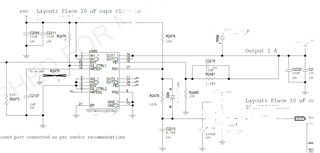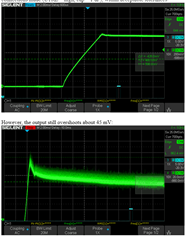With the attached circuit:
VIN = 5.2V
Vout = 0.92 V
Cout = 30 uF
We are seeing about 50 mV of overshoot during startup. Simulation in SPICE shows no overshoot. Please help us find the cause.

Plot of output at startup:

This thread has been locked.
If you have a related question, please click the "Ask a related question" button in the top right corner. The newly created question will be automatically linked to this question.
With the attached circuit:
VIN = 5.2V
Vout = 0.92 V
Cout = 30 uF
We are seeing about 50 mV of overshoot during startup. Simulation in SPICE shows no overshoot. Please help us find the cause.

Plot of output at startup:

Hi Thaun,
Unfortunately some of our online SPICE models are not very robust and hide some of the finer details of our devices performance. I can see that on our datasheet startup plots we do not show any significant startup overshoot, however they are only showing typical behaviors and not covering the entire possibility space of operation. We do specify that this device does exhibit overshoot when the softstart capacitor is 0nF and/or when fast charging is applied. You have the maximum softstart capacitor chosen, which helps reduce overshoot, but you are currently configured for fast startup, by connecting the SS_CTRL1 to the input signal. This is a likely reason for the overshoot encountered.
There are a few reasons as to why the overshoot could be occurring.
If the part is in dropout on startup, this overshoot is expected as the part needs some time to respond as it has limited bandwidth. You can mitigate this by ramping the input signal faster, and/or delaying the EN assertion to the LDO until the VIN has had more time to come up.
With 30uF of output capacitance and a maximum load, it is possible that the part is starting up in current limit as it tries to supply the load, and charge the output capacitance on that rail, this causes the part to overshoot as the pass device is driven fully on. Possible solutions to this are to decrease output capacitance to mitigate inrush current, and switch the connection of SS_CTRL1 from the input rail to GND. Both of these will allow lower peak current values either by decreasing the charge required or by slowing the ramp rate of VOUT, respectively.
Regards,
John